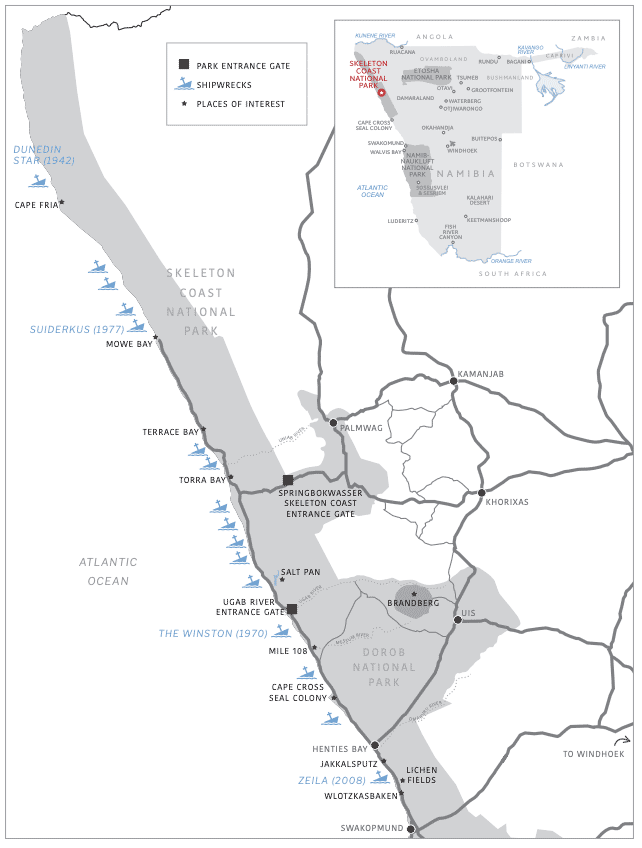



Think fog-shrouded beaches, rusting shipwrecks half-buried in desert sands, booming Atlantic swells, and seal colonies that stretch as far as the eye can see. Remote, raw and wonderfully otherworldly, this is a coastline that feels like the edge of the Earth - and that’s exactly why travellers love it.
The name “Skeleton Coast” originally came from the staggering number of whale bones that once littered these shores during the height of the whaling era. Thousands of carcasses were processed along the coastline, leaving behind vast gleaming ribcages and skulls scattered across the sand - a stark reminder of how harsh and remote this region is.
Later, as dense fog, unpredictable currents, and violent swells claimed passing vessels, shipwrecks began to join the bones. Rusting hulls and twisted metal, half-buried in sand, added a new layer of ghostliness to the name.
Today, these “skeletons” - both natural and man-made - give the region its unmistakable character.

Stretching roughly 40 kilometres wide and 500 kilometres long, from the Ugab River in the south to the Kunene River in the far north, the Skeleton Coast covers one of the most isolated stretches of shoreline in the world. The southern section is more accessible, while the northern part forms the Skeleton Coast National Park - a restricted wilderness area that can only be explored with permits or via fly-in safaris and concession-based operators.
The Skeleton Coast is famous for its shipwrecks, some stranded kilometres inland as sand dunes slowly swallow them over time. A few of the most iconic include:
The best way to see many of the remote wrecks is from the air or as part of a specialist guided expedition.
Few experiences compare to standing at Cape Cross, home to one of the world’s largest Cape fur seal colonies. Thousands upon thousands of seals crowd the shoreline - a mesmerising (and yes, pungent) sensory encounter. Seals can also be seen further north along the coastline, often with jackals weaving between them in search of scraps.
Despite the harsh environment, the Skeleton Coast supports a surprising amount of wildlife. Look out for:
Inland, the Hoanib and Huab riverbeds are among the best places in Namibia to see desert-adapted species in a truly wild setting.
Morning fog, born where warm desert air meets the cold Atlantic, drifts inland in an ethereal blanket of silver light - a photographer’s dream. Here, towering dunes plunge into icy waves, while fossil-rich plains, salt pans, lichen fields, gravel deserts, and ancient river canyons reveal the raw artistry of a landscape shaped over millennia.
The most accessible seal colony and a fascinating historical stop.
Seasonal fishing hotspots within the Skeleton Coast National Park.
Perhaps the most iconic accommodation in Namibia - cabins shaped like shipwrecks scattered across the dunes.
A remote, fly-in-only area offering desert wildlife, dramatic canyons, and a chance to follow ancient riverbeds to the sea.
A jumping-off point for shipwreck expeditions (accessible with concession holders only).
Scenic flights from Swakopmund, Damaraland, or Hoanib are a highlight for many travellers — easily the best way to appreciate the scale and drama of the landscape.
Self-driving is possible in the southern areas, but the northern coastline remains wild, regulated, and best experienced with expert guides.
Most travellers explore the Skeleton Coast from Swakopmund, Henties Bay, or Damaraland. Key access points include:
If you want to reach the dramatic dunes-meet-ocean areas, especially near Möwe Bay, a guided concession tour or lodge-based activity is essential.
The Skeleton Coast can be visited year-round, but conditions vary:
The coastline is cool even in mid-summer, so pack layers.
Accommodation is limited and intentionally low-impact:
Lodges in Damaraland and Kaokoland with day trips or fly-in excursions.
Cape Cross, Torra Bay and Terrace Bay operate seasonally.
Wherever you stay, expect remote settings, incredible scenery, and some of Namibia’s most memorable experiences.
This is not a place where you just pop into a shop if you forget something.
The Skeleton Coast is fragile. Stick to designated tracks, respect lichen fields, and avoid disturbing wildlife. Much of the region forms part of protected conservancies and community areas, where tourism plays a crucial role in conserving this extraordinary wilderness.
The Skeleton Coast is Namibia at its wildest. Stark, silent, and unforgettable, it’s a place where the desert meets the sea in a collision of drama and beauty. Whether you come for the shipwrecks, the seals, the landscapes, or the sheer sense of remoteness, you’ll leave knowing you’ve travelled somewhere truly extraordinary. Contact us now to find out more.




"A dream come true"
We had the most amazing family holiday, everything worked so perfectly, the arrangements and accommodation was spectacular!
"Unforgettable trip to Namibia – Thank you Namibia Tours & Safaris!"
We are a group of four from Romania and spent 3 unforgettable weeks in Namibia. We can't recommend them enough, and for any future travels in Namibia or other parts of Africa, we will definitely use their services again.
"We had a great experience"
From the time we put the key in the ignition till we boarded the plane in Windhoek nothing went wrong.
"Unforgettable bird photography trip in Namibia"
It was a fantastic experience, everything was very well organised, went smooth and according to expectations. It was our first self drive in Africa and it was a great, unforgettable time.